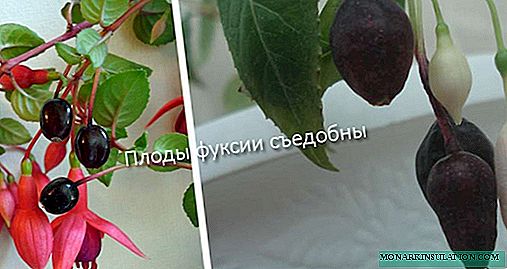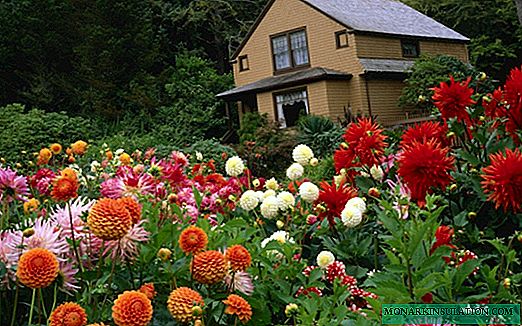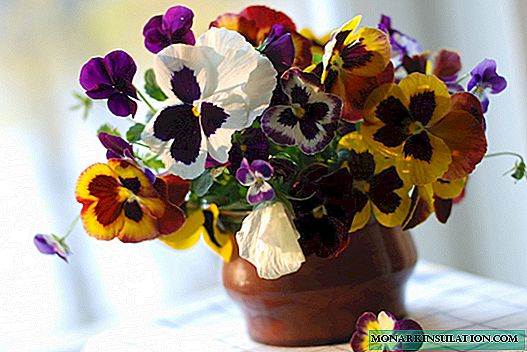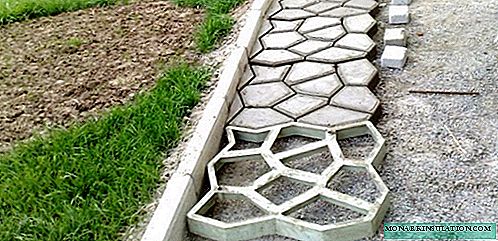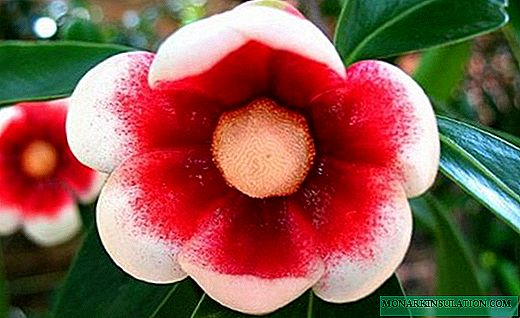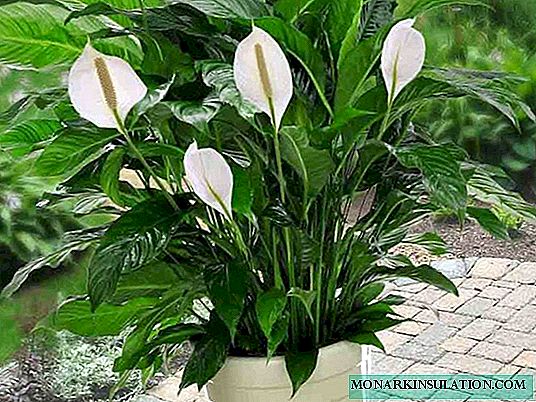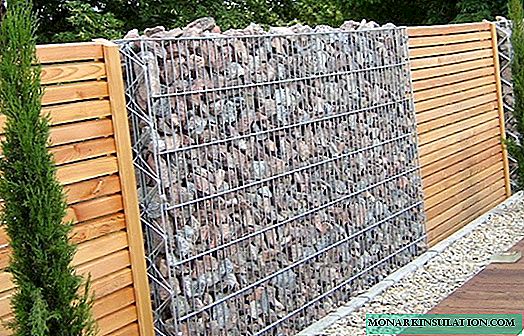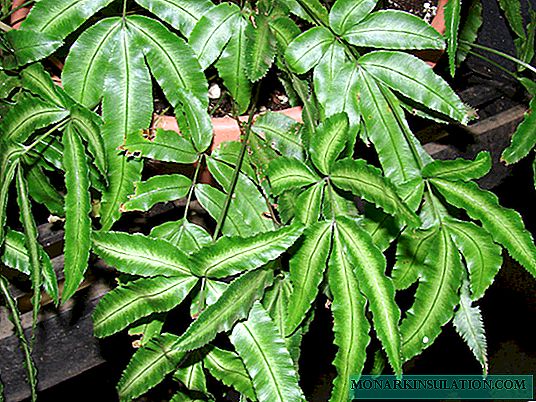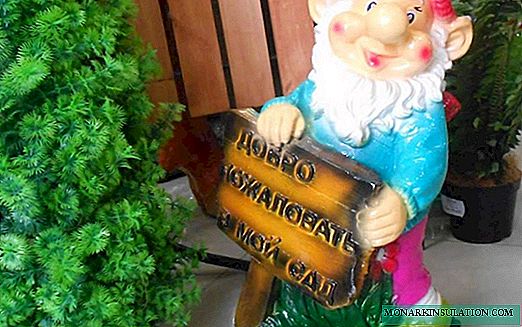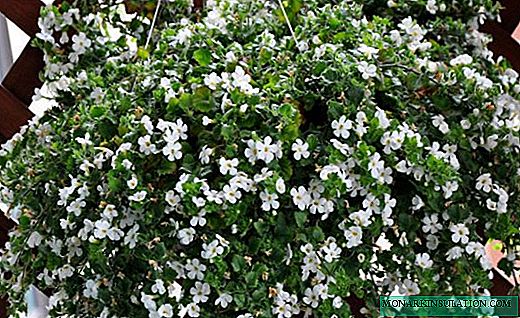Bacopa is a creeping perennial plant with grassy shoots covered with miniature leaves and many flowers. Plants belong to the plantain family. They are common in marshy and coastal areas of the tropical and subtropical climate of Latin America, Africa, Australia and South Asia. The flower can also be found under the name "Sutera." In our country, Bacopa is more likely a novice, but she is so charming and unpretentious that she deserves the closest attention of gardeners.

Botanical Description
Bacopa is a grassy rhizome plant with flexible, creeping shoots. The fibrous root system is located very close to the surface of the earth. Although the length of the shoots can reach 70 cm, the perennial height does not exceed 10-15 cm. The stem lying directly on the ground in the internodes can take root. Along its entire length, small lanceolate or wide-oval leaflets on short petioles are located close to each other. They grow in pairs, cross to cross. Bright green leaves on the sides are covered with small notches.
Bacopa flowering is very long and plentiful. Almost the entire warm season, shoots are decorated with small axillary flowers. They bloom as if in waves: now more abundant, then less, but they are constantly present on the plant. The correct corolla consists of 5 petals fused at the base into a short tube. Flowers of different varieties are painted in red, pink, white, purple or blue. Their diameter does not exceed 2 cm. The core consists of short stamens with large bright yellow anthers and ovaries. After pollination, small flattened boxes with dry walls ripen. They contain many dusty seeds.

















Species and decorative varieties
To date, the genus has more than 60 species of plants. Breeders based on them have bred a lot of decorative varieties, which differ mainly in the color of the petals. There is even a variety on which flowers of various colors bloom simultaneously.
Bacopa ampelous. The perennial plant has long creeping shoots that look very nice in flower pots or in tall flowerpots. Thin stems are densely covered with opposite bright green ovate leaves with serrate edges. During flowering (from May to October), the plant is covered with many tubular flowers with widely bent petals. Varieties:
- Olympic Gold - shoots up to 60 cm long are covered with small golden-green leaves, as well as white flowers;
- Bluetopia - stems up to 30 cm long are dotted with small olive-green leaves and bluish-lilac flowers;
- Scopia Double Blue is a perennial groundcover with bright green leaves and large pink-purple flowers.

Bacopa Monier. Flexible stems creep on the ground. They are covered with regular sessile leaves of an obovate shape. Bell-shaped flowers with a diameter of 1-2 cm are painted in white, purple or blue. The plant is found on flooded soils and can grow partially in the water column.

Bacopa Caroline. This perennial grows in swampy areas or in fresh water. Stems up to 30 cm tall grow directly, they are covered with opposite oval leaves of a light green hue. When exposed to direct sunlight, the foliage becomes copper-red. Blossoms in bright blue small colors.

Bacopa is Australian. A short, thin-stem plant develops in the water column. Shoots are covered with opposite round or oval leaves up to 18 mm long. The foliage is painted in a light green tint. Flowers bloom on the surface of the processes. Their petals are light blue in color.

Breeding methods
Bacopa propagates by seed and vegetative methods. For vegetative propagation, parts of shoots 8-10 cm long are used. Cuttings are best cut in January-March or in August-September. They are rooted in a moist sandy peat substrate. The bottom pair of leaves should be buried in the soil, it is from it that in a few days the first roots will appear.
Often, shoots that come into contact with the ground, even without separation from the mother plant, form roots. It is enough to cut off such an ingrained shoot and transplant it with a lump of earth to a new place.

Seedlings are pre-grown from bacopa seeds. To do this, in the spring, the containers are filled with loose soil, which is abundantly moistened. The smallest seeds are mixed with sawdust and distributed on the surface of the earth. It is enough to squeeze them out using a plank. The containers are covered with a film or a lid and placed in a well-lit room with a temperature of + 20 ... + 22 ° C. The tank is daily ventilated and sprayed. Shoots appear in 10-14 days. When the seedlings grow 1-2 real leaves, they are dived into another container with a distance of 2 cm. When re-picked after 2-3 weeks, the lower pair of leaves is buried. Already at this time, the soil should be fertilized with mineral fertilizing. When the air temperature outside is set at + 12 ... + 15 ° C, seedlings begin to endure for several hours for hardening. A week later, the plants are planted in open ground or flower pots in a permanent place.
Plant care
Caring for the bacopa is not too complicated, but the plant needs to be given attention.

Landing. Bacopa can be planted in open ground or in pots. It is worth remembering that in a temperate climate, bacopa does not winter and is grown in the garden as an annual. Planting soil should have low acidity. Mixtures of the following components are suitable:
- sand (2 parts);
- deciduous humus (2 parts);
- sheet land (1 part);
- peat (1 part).
Lighting. In order for the flowering to be plentiful enough, the plant must be kept in bright diffused light. The direct rays of the midday sun can cause burns. Small penumbra is allowed.

Temperature. Bacopa is resistant to nighttime cooling and drafts. It can grow on the street from May to October. The plant withstands frosts down to -5 ° C, but not for long. In winter, indoor plants should be kept at a temperature of + 10 ... + 15 ° C. In this case, the shoots will remain compact, and in the spring a new wave of plentiful flowering will come. If the bacopa is kept warm in winter, the leaves will begin to dry and fall off.
Watering. Bacopas love moisture; the soil should always be slightly moist. Infrequent flooding of the soil is allowed. Water the plant with soft, well-purified water.
Fertilizer. Since the flower actively builds up green mass and blooms for a long time, without fertilizing it is too depleted. From March to October, three times a month, the bacopa is fertilized with a solution of the mineral complex for flowering plants.

Pruning. Even on young plants, they begin to pinch the tips of the shoots to form lateral processes. After wintering, it is necessary to cut to half the stems, especially if they are stretched and bare.
Diseases and pests. Bacopa is resistant to plant diseases and most pests. Only occasionally in shady places or in severe drought, its crown is affected by aphids and whiteflies. After the first treatment with the insecticide, the pests will disappear. To get rid of the larvae, re-spraying is carried out after a week.
Bacopa in the aquarium
Some species of bacopa, for example, Caroline and Australian, in the natural environment grow in marshy areas or in the water column. They can be used for landscaping the aquarium. Plants are very unpretentious, undemanding to the purity of water and quickly grow shoots. Thanks to these benefits, they are ideal for beginner aquarists.

In order for the bacopa to develop well, it is necessary to provide it with intensive lighting. Water should be soft and slightly acidified. In a hard liquid, as well as with a lack of heat, growth slows down or completely stops. The optimum water temperature for the growth of bacopa is + 18 ... + 30 ° C. It is also necessary to plant it in nutritious soil rich in organic impurities. Some species bloom right under the water, but most bloom flowers on the surface of the stem.
Using
Long, fast-growing stems of bacopa are densely dotted with flowers and leaves. They are excellent for ampel growing on balconies, terraces, and in the garden. The cache-pot can be placed in the yard on columns of arbors or on the walls of the house. Bacopa can easily withstand the heat, strong gusts of wind and thunder, and at the same time retain its attractiveness.
Also, plants can be used as ground cover on the ground or on rocky slopes. With their help, they adorn the banks of ponds and other relief objects. It perfectly withstands flower immersion in water and flooding. Shoots can cling to any surface, forming horizontal or vertical dense carpets. With the help of a bacopa, you can create a decent frame for a flower garden. It looks good near petunia, nasturtium, fuchsia, lobelia.

